3.5: Practice - Sex linkage
- Page ID
- 73543
\( \newcommand{\vecs}[1]{\overset { \scriptstyle \rightharpoonup} {\mathbf{#1}} } \)
\( \newcommand{\vecd}[1]{\overset{-\!-\!\rightharpoonup}{\vphantom{a}\smash {#1}}} \)
\( \newcommand{\dsum}{\displaystyle\sum\limits} \)
\( \newcommand{\dint}{\displaystyle\int\limits} \)
\( \newcommand{\dlim}{\displaystyle\lim\limits} \)
\( \newcommand{\id}{\mathrm{id}}\) \( \newcommand{\Span}{\mathrm{span}}\)
( \newcommand{\kernel}{\mathrm{null}\,}\) \( \newcommand{\range}{\mathrm{range}\,}\)
\( \newcommand{\RealPart}{\mathrm{Re}}\) \( \newcommand{\ImaginaryPart}{\mathrm{Im}}\)
\( \newcommand{\Argument}{\mathrm{Arg}}\) \( \newcommand{\norm}[1]{\| #1 \|}\)
\( \newcommand{\inner}[2]{\langle #1, #2 \rangle}\)
\( \newcommand{\Span}{\mathrm{span}}\)
\( \newcommand{\id}{\mathrm{id}}\)
\( \newcommand{\Span}{\mathrm{span}}\)
\( \newcommand{\kernel}{\mathrm{null}\,}\)
\( \newcommand{\range}{\mathrm{range}\,}\)
\( \newcommand{\RealPart}{\mathrm{Re}}\)
\( \newcommand{\ImaginaryPart}{\mathrm{Im}}\)
\( \newcommand{\Argument}{\mathrm{Arg}}\)
\( \newcommand{\norm}[1]{\| #1 \|}\)
\( \newcommand{\inner}[2]{\langle #1, #2 \rangle}\)
\( \newcommand{\Span}{\mathrm{span}}\) \( \newcommand{\AA}{\unicode[.8,0]{x212B}}\)
\( \newcommand{\vectorA}[1]{\vec{#1}} % arrow\)
\( \newcommand{\vectorAt}[1]{\vec{\text{#1}}} % arrow\)
\( \newcommand{\vectorB}[1]{\overset { \scriptstyle \rightharpoonup} {\mathbf{#1}} } \)
\( \newcommand{\vectorC}[1]{\textbf{#1}} \)
\( \newcommand{\vectorD}[1]{\overrightarrow{#1}} \)
\( \newcommand{\vectorDt}[1]{\overrightarrow{\text{#1}}} \)
\( \newcommand{\vectE}[1]{\overset{-\!-\!\rightharpoonup}{\vphantom{a}\smash{\mathbf {#1}}}} \)
\( \newcommand{\vecs}[1]{\overset { \scriptstyle \rightharpoonup} {\mathbf{#1}} } \)
\(\newcommand{\longvect}{\overrightarrow}\)
\( \newcommand{\vecd}[1]{\overset{-\!-\!\rightharpoonup}{\vphantom{a}\smash {#1}}} \)
\(\newcommand{\avec}{\mathbf a}\) \(\newcommand{\bvec}{\mathbf b}\) \(\newcommand{\cvec}{\mathbf c}\) \(\newcommand{\dvec}{\mathbf d}\) \(\newcommand{\dtil}{\widetilde{\mathbf d}}\) \(\newcommand{\evec}{\mathbf e}\) \(\newcommand{\fvec}{\mathbf f}\) \(\newcommand{\nvec}{\mathbf n}\) \(\newcommand{\pvec}{\mathbf p}\) \(\newcommand{\qvec}{\mathbf q}\) \(\newcommand{\svec}{\mathbf s}\) \(\newcommand{\tvec}{\mathbf t}\) \(\newcommand{\uvec}{\mathbf u}\) \(\newcommand{\vvec}{\mathbf v}\) \(\newcommand{\wvec}{\mathbf w}\) \(\newcommand{\xvec}{\mathbf x}\) \(\newcommand{\yvec}{\mathbf y}\) \(\newcommand{\zvec}{\mathbf z}\) \(\newcommand{\rvec}{\mathbf r}\) \(\newcommand{\mvec}{\mathbf m}\) \(\newcommand{\zerovec}{\mathbf 0}\) \(\newcommand{\onevec}{\mathbf 1}\) \(\newcommand{\real}{\mathbb R}\) \(\newcommand{\twovec}[2]{\left[\begin{array}{r}#1 \\ #2 \end{array}\right]}\) \(\newcommand{\ctwovec}[2]{\left[\begin{array}{c}#1 \\ #2 \end{array}\right]}\) \(\newcommand{\threevec}[3]{\left[\begin{array}{r}#1 \\ #2 \\ #3 \end{array}\right]}\) \(\newcommand{\cthreevec}[3]{\left[\begin{array}{c}#1 \\ #2 \\ #3 \end{array}\right]}\) \(\newcommand{\fourvec}[4]{\left[\begin{array}{r}#1 \\ #2 \\ #3 \\ #4 \end{array}\right]}\) \(\newcommand{\cfourvec}[4]{\left[\begin{array}{c}#1 \\ #2 \\ #3 \\ #4 \end{array}\right]}\) \(\newcommand{\fivevec}[5]{\left[\begin{array}{r}#1 \\ #2 \\ #3 \\ #4 \\ #5 \\ \end{array}\right]}\) \(\newcommand{\cfivevec}[5]{\left[\begin{array}{c}#1 \\ #2 \\ #3 \\ #4 \\ #5 \\ \end{array}\right]}\) \(\newcommand{\mattwo}[4]{\left[\begin{array}{rr}#1 \amp #2 \\ #3 \amp #4 \\ \end{array}\right]}\) \(\newcommand{\laspan}[1]{\text{Span}\{#1\}}\) \(\newcommand{\bcal}{\cal B}\) \(\newcommand{\ccal}{\cal C}\) \(\newcommand{\scal}{\cal S}\) \(\newcommand{\wcal}{\cal W}\) \(\newcommand{\ecal}{\cal E}\) \(\newcommand{\coords}[2]{\left\{#1\right\}_{#2}}\) \(\newcommand{\gray}[1]{\color{gray}{#1}}\) \(\newcommand{\lgray}[1]{\color{lightgray}{#1}}\) \(\newcommand{\rank}{\operatorname{rank}}\) \(\newcommand{\row}{\text{Row}}\) \(\newcommand{\col}{\text{Col}}\) \(\renewcommand{\row}{\text{Row}}\) \(\newcommand{\nul}{\text{Nul}}\) \(\newcommand{\var}{\text{Var}}\) \(\newcommand{\corr}{\text{corr}}\) \(\newcommand{\len}[1]{\left|#1\right|}\) \(\newcommand{\bbar}{\overline{\bvec}}\) \(\newcommand{\bhat}{\widehat{\bvec}}\) \(\newcommand{\bperp}{\bvec^\perp}\) \(\newcommand{\xhat}{\widehat{\xvec}}\) \(\newcommand{\vhat}{\widehat{\vvec}}\) \(\newcommand{\uhat}{\widehat{\uvec}}\) \(\newcommand{\what}{\widehat{\wvec}}\) \(\newcommand{\Sighat}{\widehat{\Sigma}}\) \(\newcommand{\lt}{<}\) \(\newcommand{\gt}{>}\) \(\newcommand{\amp}{&}\) \(\definecolor{fillinmathshade}{gray}{0.9}\)Query \(\PageIndex{1}\)
- Step-by-step solution
-
- Cells that have missing or extra chromosomes are said to be aneuploid.
Most aneuploidies, including those of sex chromosomes, occur during the production of gametes (sperm or eggs) - When pairs of homologous chromosomes or sister chromatids fail to separate during meiosis I or II, gametes with too many or too few chromosomes can be produced.
- When an aneuploid sperm or egg combines with a normal sperm or egg in fertilization, it makes a zygote that is also aneuploid.

For instance, if a sperm containing an extra \(\text{X}\) chromosome, (making it \(\text{XY}\) instead of \(\text{Y}\)) combines with a normal egg cell (\(\text{X}\)), the resulting zygote will have a sex chromosome composition of \(\text{XXY}\) rather than the normal \(\text{XY}\).
- The correct answer is
Nondisjunction occurred during meiosis
- Cells that have missing or extra chromosomes are said to be aneuploid.
Query \(\PageIndex{2}\)
- Step-by-step solution
-
- If the woman has the trait, then her genotype must be \(\text{X}^a\text{X}^a\).
A male who does not have the trait must have a genotype of \(\text{X}^A\text{Y}\) -
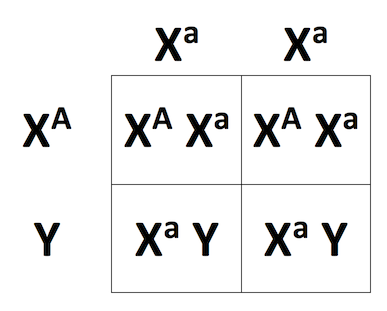
In order for a son to be affected he must be \(\text{X}^a\text{Y}\).
All sons produced by this cross will have this genotype. - The correct answer is
There is a 100% chance he will be affected.
- If the woman has the trait, then her genotype must be \(\text{X}^a\text{X}^a\).
Query \(\PageIndex{3}\)
- Step-by-step solution
-
- Aneuploidy refers to an abnormal number of chromosomes - either an additional chromosome or missing chromosomes.
- Each human gamete should have one sex chromosome.
Male gametes can have either an X or a Y chromosome, and female gametes should have one X chromosome. - If a cell has too many chromosomes, such as an egg having two X-chromosomes, the cell has likely undergone nondisjunction.
This means the cell did not properly divide its material during meiosis. - The correct answer is
An egg contains two X chromosomes.
Query \(\PageIndex{4}\)
- Step-by-step solution
-
- The cross for these parents is \(\text{X}^H\text{Y}\) and \(\text{X}^H\text{X}^h\).
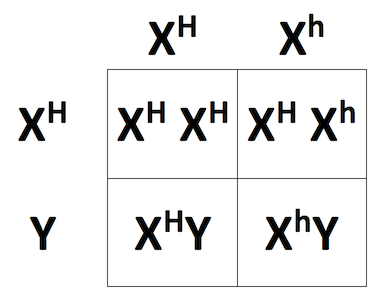
- If we look at the Punnett square, we see that the possible offspring produced by this cross are:
- \(\text{X}^H\text{X}^H\)
- daughter, unaffected
- \(\text{X}^H\text{X}^h\)
- daughter, unaffected carrier
- \(\text{X}^H\text{Y}\)
- son, unaffected
- \(\text{X}^h\text{Y}\)
- son, affected
- \(\text{X}^H\text{X}^H\)
- The correct answer is
No daughter they have will be affected.
- The cross for these parents is \(\text{X}^H\text{Y}\) and \(\text{X}^H\text{X}^h\).
Query \(\PageIndex{5}\)
- Step-by-step solution
-
- Normally, male cats do not show a calico coat pattern because they have only one X chromosome, and cannot carry out X-inactivation.
Instead, they simply display the solid coat color corresponding to the allele of the coat color gene found on their single X.
However, the X-inactivation system is still present in males, even though they don't typically use it, and can come into play if a male receives an unusually high number of X chromosomes. - The X inactivation system can occur if a male receives an unusually high number of X chromosomes.
XXY individuals develop as outwardly male, but since only one X can be active in each cell, one of the two X chromosomes will be randomly inactivated during his development, resulting in the same calico pattern seen in heterozygous females. - The correct answer is
The male kitten has a genotype of XXY.
- Normally, male cats do not show a calico coat pattern because they have only one X chromosome, and cannot carry out X-inactivation.
Query \(\PageIndex{6}\)
- Step-by-step solution
-
- The cross for these parents is \(\text{X}^H\text{Y}\) and \(\text{X}^h\text{X}^h\).
- While you can complete a Punnett square for this cross, the simplest way to figure out the answer to this problem is by recognizing that a male offspring always inherits his X-chromosome from his mother.
Because the mother's genotype is \(\text{X}^h\text{X}^h\), she can only contribute an \(\text{X}^h\) to her sons.
This means that all of the sons will be \(\text{X}^h\text{Y}\) after getting the hemophiliac gene from the mother and the Y-chromosome from the father.- [Let me see the Punnett square!]
-
The question asks specifically for the probability of males having hemophilia. If we look at our Punnett square, we find that there are two boxes with male offspring.
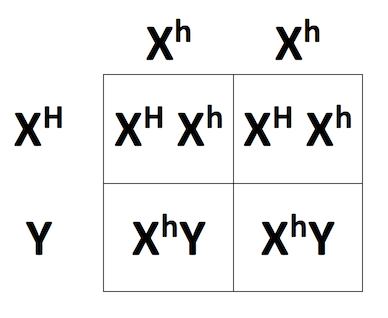
In order for a male to have the trait, he must have a genotype of \(\text{X}^h\text{Y}\). Of the two male offspring boxes, 2/2 have this genotype.
This means that 2/2, or 100%, of the males will be hemophiliacs.
- The correct answer is
100%
Query \(\PageIndex{7}\)
- Step-by-step solution
-
- Because all of the male offspring have white eyes, and white eyes are a recessive sex-linked trait, the male offspring's genotypes must be \(\text{X}^w\text{Y}\).
The only option for the father to have a normal phenotype is if his genotype is \(\text{X}^W\text{Y}\). - In order to have a normal phenotype, the mother must be either \(\text{X}^W\text{X}^W\) or \(\text{X}^W\text{X}^w\).
However, because a male offspring always inherits his X chromosome from his mother, she must be able to donate a \(\text{X}^w\) allele to her male offspring for them to have white eyes.
This leaves only one option for the mother's genotype: \(\text{X}^W\text{X}^w\). - The correct answer is
\(\text{X}^W\text{X}^w\) and \(\text{X}^W\text{Y}\)
- Because all of the male offspring have white eyes, and white eyes are a recessive sex-linked trait, the male offspring's genotypes must be \(\text{X}^w\text{Y}\).
Query \(\PageIndex{8}\)
- Step-by-step solution
-
- Because of X-inactivation, X chromosome aneuploidies are generally less harmful than autosome aneuplodies.
This is because the X-inactivation that shuts down the second X of an XX female can also shut down excess X chromosomes if they are present. - Male sex chromosome aneuploidy occurs as either multiples of X or Y chromosomes or both. Common affected genotypes may be XXY or XYY.
The presence or absence of a Y chromosome determines biological sex in humans, despite aneuploidy. - The correct answer is
Male sex chromosome aneuploidy can affect either the X or Y chromosome.
- Because of X-inactivation, X chromosome aneuploidies are generally less harmful than autosome aneuplodies.
Query \(\PageIndex{9}\)
- Step-by-step solution
-
- Females have two X-chromosomes. Thus, their sex chromosomes can be
- \(\text{X}^D\text{X}^D\)
- normal
- \(\text{X}^D\text{X}^d\)
- carrier
- \(\text{X}^d\text{X}^d\)
- DMD
Since a female must have two \(\text{X}^d\) alleles to have DMD, it is less likely that females will express the trait.
- \(\text{X}^D\text{X}^D\)
- Because males only have one X-chromosome, whatever allele is present on that single X-chromosome will be expressed.
- The correct answer is
Males only have one copy of the X chromosome.
- Females have two X-chromosomes. Thus, their sex chromosomes can be
Query \(\PageIndex{10}\)
- Step-by-step solution
-
- Because red-green colorblindness is a recessive disorder, a woman must receive two colorblindness alleles (one on each X chromosome) in order to be colorblind.
Therefore, a daughter can only be colorblind if she gets a colorblind allele from each her mother and her father. - Males only have one X chromosome, so in order to have a colorblind allele that can be passed on to offspring, the male must be colorblind (\(\text{X}^b\text{Y}\)).
Women who are either homozygous for colorblindess (\(\text{X}^b\text{X}^b\)) or a carrier (\(\text{X}^B\text{X}^b\)) may pass on the colorblind allele to their offspring. - The correct answer is
A carrier mother and a colorblind father
- Because red-green colorblindness is a recessive disorder, a woman must receive two colorblindness alleles (one on each X chromosome) in order to be colorblind.
Query \(\PageIndex{11}\)
- Step-by-step solution
-
- If the woman is a carrier, but does not have the trait, then her genotype must be \(\text{X}^B\text{X}^b\).
A male who does not have the trait must have a genotype of \(\text{X}^B\text{Y}\) -
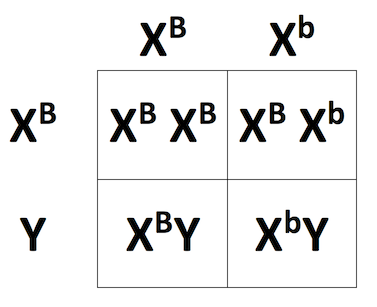
In order for a son to be affected he must be \(\text{X}^b\text{Y}\).
There is a 1 in 4 chance that they will produce a child with this genotype. - The correct answer is
They have a 25% chance of having an affected son.
- If the woman is a carrier, but does not have the trait, then her genotype must be \(\text{X}^B\text{X}^b\).
Query \(\PageIndex{12}\)
- Step-by-step solution
-
- The cross for these parents is \(\text{X}^a\text{Y}\) and \(\text{X}^A\text{X}^A\).
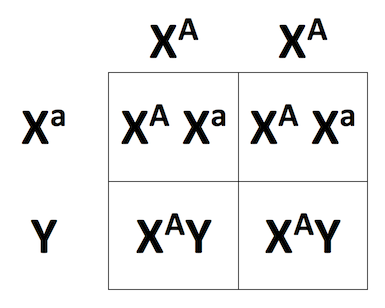
- In order for a daughter to have the trait, she must have a genotype of \(\text{X}^a\text{X}^a\). Of the two daughter offspring boxes, 0/2 have this genotype.
This means that 0/2, or 0%, of the daughters will have ocular albinism. - The correct answer is
- The cross for these parents is \(\text{X}^a\text{Y}\) and \(\text{X}^A\text{X}^A\).
Contributors and Attributions
Khan Academy (CC BY-NC-SA 3.0; All Khan Academy content is available for free at www.khanacademy.org)

